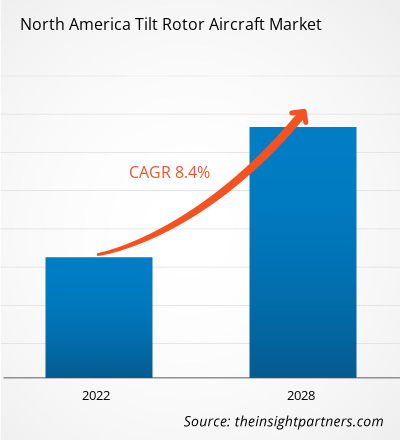The tilt rotor aircraft market in North America is expected to grow from US$ 854.02 million in 2021 to US$ 1,506.46 million by 2028; it is estimated to grow at a CAGR of 8.4% from 2021 to 2028.
The US, Canada, and Mexico are major economies in North America. Lower operating cost of tilt rotor aircraft. A tilt rotor aircraft generates its lift and propulsion with the help of rotors that are mounted at the end of the fixed wing. The rotors are vertically tilted to generate lift and further the aircraft gradually gains forward momentum as the rotors are tilted in horizontal direction. Thus, this enables the aircraft to have vertical take-off and landing capability (VTOL) of a rotary wing aircraft and the range & speed of a fixed wing aircraft. This capability eliminates the need for dedicated landing strip for such aircraft. Also, such aircraft are considered more efficient compared to a rotary wing aircraft when it comes to transporting people and goods within short distance. As rotary wing aircraft are widely used for travelling shorter distance, the operating cost of rotary wing aircraft is generally at higher side compared to fixed wing aircraft. Thus, utilizing tilt rotor aircraft for transportation application enables end users to save significant amount of operation cost. Owing to the aforementioned advantages of tilt rotor aircraft, the market is anticipated to witness steady growth during the forecast period. is also bolstering the growth of the industry.North American market suffered substantial economic loss in the first half of 2020 owing to the high number of COVID-19 cases, specifically in the US. The economic growth had slowed, which delayed the ongoing projects of military and defense up-gradation. The US is one of the major exporters of arms products, but due to the disrupted supply chain and lower economic conditions of importing countries, export revenue is reduced. Enhancing trade relations to support international supply post lockdown helped the market to regain its position. The limited workforce strength due to the physical distancing model hampered the production activities in-country. Also, the disruption in defense electronics supply chain caused hindered the growth of the US tilt rotor aircraft market.

- This FREE sample will include data analysis, ranging from market trends to estimates and forecasts.
North America Tilt Rotor Aircraft Market Segmentation
North America Tilt Rotor Aircraft Market – By Type
- Unmanned Aerial Vehicle
- Manned Aerial Vehicle
North America Tilt Rotor Aircraft Market – By End User
- Civil
- Military
North America Tilt Rotor Aircraft Market, by Country
- US
- Canada
- Mexico
North America Tilt Rotor Aircraft Market Mentioned
- BAE Systems plc
- Bell Textron Inc
- Boeing
- Honeywell International Inc.
- Israel Aerospace Industries Ltd.
- Leonardo S.p.A
- Lockheed Martin Corporation
- Northrop Grumman Corporation
North America Tilt Rotor Aircraft Report Scope
| Report Attribute | Details |
|---|---|
| Market size in 2021 | US$ 854.02 Million |
| Market Size by 2028 | US$ 1,506.46 Million |
| Global CAGR (2021 - 2028) | 8.4% |
| Historical Data | 2019-2020 |
| Forecast period | 2022-2028 |
| Segments Covered |
By Type
|
| Regions and Countries Covered | North America
|
| Market leaders and key company profiles |
- Historical Analysis (2 Years), Base Year, Forecast (7 Years) with CAGR
- PEST and SWOT Analysis
- Market Size Value / Volume - Global, Regional, Country
- Industry and Competitive Landscape
- Excel Dataset


- Queue Management System Market
- Digital Language Learning Market
- Single-Use Negative Pressure Wound Therapy Devices Market
- Medical Collagen Market
- Wire Harness Market
- Battery Testing Equipment Market
- Customer Care BPO Market
- Genetic Testing Services Market
- Water Pipeline Leak Detection System Market
- Dairy Flavors Market

Report Coverage
Revenue forecast, Company Analysis, Industry landscape, Growth factors, and Trends

Segment Covered
Type and End User

Regional Scope
North America, Europe, Asia Pacific, Middle East & Africa, South & Central America

Country Scope
US, Canada
Trends and growth analysis reports related to Aerospace and Defense : READ MORE..
- BAE Systems plc
- Bell Textron Inc
- Boeing
- Honeywell International Inc.
- Israel Aerospace Industries Ltd.
- Leonardo S.p.A
- Lockheed Martin Corporation
- Northrop Grumman Corporation

 Get Free Sample For
Get Free Sample For